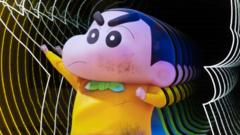"NASA's Stranded Astronauts Face Shocking Dangers on Upcoming Spacewalk"

Published: 2025-01-21 10:10:51 | Category: News
NASA’s two astronauts, Butch Wilmore and Sunita Williams, are making headlines this week as they prepare for an unexpected spacewalk after spending over seven months in orbit. This thrilling event marks a significant moment for both astronauts, especially for Butch, who hasn’t been outside since a ride home went awry last June.
Sunita, now the commander of the International Space Station, is gearing up for her second spacewalk in just about a week. Together, they will embark on a mission to conduct repairs and collect samples to investigate the presence of microorganisms on the station's exterior. While some may view them as space castaways, these highly skilled professionals are ready to engage in the ultimate astronaut dream before their return to Earth this spring.
So, what can we expect from a spacewalk? Dr. Kirsty Lindsay, an expert in astronaut health, describes it as akin to the most intense workout one could imagine. Astronauts don heavy, bulletproof suits and must navigate tricky maneuvers while breathing canned air for six to eight hours without food and with limited hydration.
The mental challenges can be just as significant. Dr. Lindsay likens the experience to the sense of relief many felt when allowed to step outside during the 2020 lockdowns. For astronauts, going for an EVA (extravehicular activity) is the ultimate escape from confinement. Many astronauts share a transformative experience called the Overview Effect, where they gain a profound understanding of Earth’s fragility while gazing into the vastness of space.
Butch’s first venture outside in months will surely bring a rush of wonder and excitement, while Sunita may still feel the physical toll of her previous spacewalk. Prior to stepping out, they will spend time in a special airlock compartment, breathing 100% oxygen to minimize the risk of the bends, a condition that can occur when nitrogen bubbles form in the bloodstream.
Once outside, constant communication with their partners will be essential, as they work independently. One major concern is hydration, as they will sweat profusely while only having a limited water supply. Their heart rates will be closely monitored, allowing for a quick return if stress levels rise.
Additionally, astronauts must be cautious of vertigo or dizziness, which often occurs when they first exit the airlock. To mitigate this, NASA has devised strategies, such as keeping a solar panel in view to provide a grounding reference.
Safety is paramount, especially concerning micrometeoroids, which can potentially puncture suits. NASA monitors space debris closely, ensuring that the astronauts' spacewalk is scheduled to avoid any imminent threats. The suits are designed to seal around any impact site, providing an added layer of protection.
After the spacewalk, astronauts face the relief of removing their suits, which often leave them sweaty from exertion. They’ll have a chance to rest, recharge, and perhaps even deal with the realities of using a Maximum Absorbency Garment—essentially a space diaper—if nature calls during their mission.
While Butch and Sunita didn’t anticipate such an extended stay, long missions on the ISS are becoming increasingly common. As our aspirations for deep space exploration evolve—such as the development of the Gateway space station for lunar habitation and ambitions to reach Mars—we need to understand the effects of prolonged space living. Their unexpected mission provides invaluable data to enhance preparations for future journeys beyond low Earth orbit.
What are your thoughts on the challenges astronauts face during spacewalks?
#SpaceExploration #NASA #Astronauts



